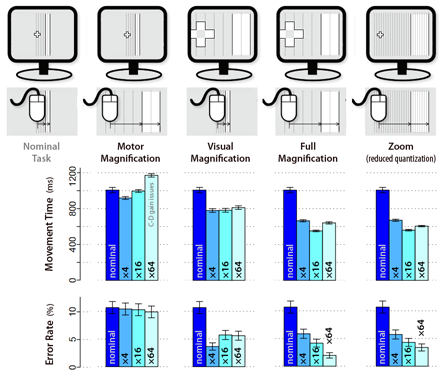 Small Target Acquisition
Small Target Acquisition Small Target Acquisition
Small Target Acquisition
Pointing at targets of only a few pixels is notoriously difficult. Despite the many interaction techniques proposed to facilitate these tasks, the reasons for their difficulty are still poorly understood. We conducted a study that confirms a strong departure from Fitts' Law for small target acquisition using a mouse. We separately investigated three potential sources of problems: motor accuracy, legibility, and quantization (i.e., the fact that the mouse cursor jumps by one-pixel increments). To this end, we had subjects acquire very small targets and scaled up these tasks in ways that preserve Fitts' IDs (click on the image below).

We found that quantization is not a problem, but both motor and visual sizes play a role, in contradiction with the conventional wisdom that motor accuracy is the only limiting factor. This suggests that small targets should be magnified in both motor and visual spaces to facilitate pointing. Since performance degrades quickly as targets get very small, we further advocate the exploration of target-agnostic magnification strategies (e.g., temporary zooming), which do not have the issues of target-aware techniques and should be effective despite leaving Fitts' IDs unchanged. We also confirm Welford's 1969 proposal that motor inaccuracy can be modeled by subtracting a "tremor constant" from target size. We argue for the adoption of this model, rather than Fitts' law, when reflecting on small target acquisition.
2008
2011 - complete and fixed version:
| License info |  |